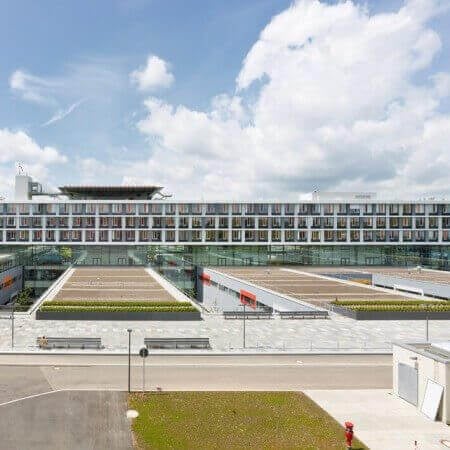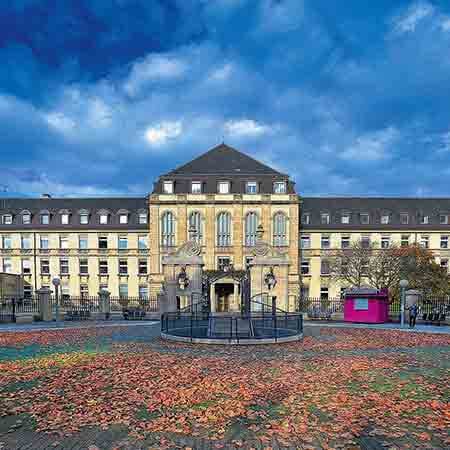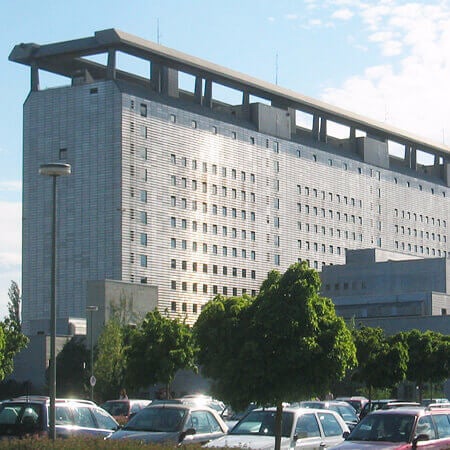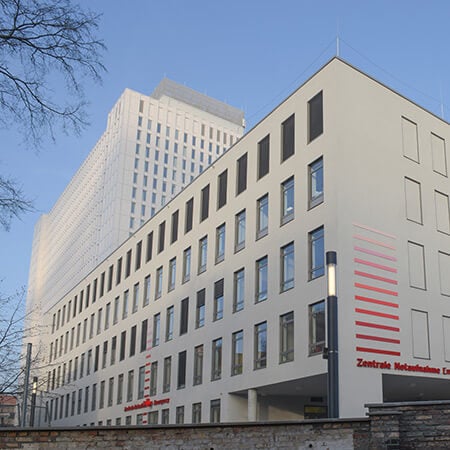Multiple myeloma
Due to the difficulties associated with the organization of treatment in Turkey, Switzerland, South Korea and India, we are not currently processing requests to these regions.
If you are interested in treatment in Germany, please leave a request and our specialists will contact you as soon as possible.
Multiple myeloma is a malignant tumor that arises from differentiated B-cells (plasma cells). The occurrence of the disease is 2-3 cases per 100,000 of population per year. Men suffer 1.5 times more often than women. Negroid race representatives are under higher risks, while multiple myeloma is not common among the Japanese and Chinese.
The Booking Health portal presents 53 German clinics specializing in multiple myeloma treatment
Show all clinics
Multiple myeloma – Diagnostics
The main methods of multiple myeloma diagnostics are:
- Sternal puncture (bone marrow aspiration from the sternum)
- Blood serum test for detecting monoclonal antibodies produced by malignant cells (using immunoelectrophoresis or immune fixation methods)
- X-ray methods of examination with the evaluation of bones condition
Diagnosis criteria:
- Presence of 10% tumor plasma cells in the bone marrow punctate. Only rarely it appears to be normal (punctate of the sternum in 10% of patients with the solitary myeloma). In this case, the material for the study is taken from the bone tumors, extramedullary foci, and osteolytic defects.
- According to the immunoelectrophoresis data, the IgG is higher than 3.5 g/100 ml, and IgA is higher than 2 g/100 ml or excretion of immunoglobulin light chains (Bence Jones proteinuria) with urine is over 1 g per 24 hours.
- Presence the foci of bone destruction, osteoporosis, reducing the height of the vertebrae and other radiological signs of multiple myeloma on the X-ray images.
The first two criteria are the main ones. They make an accurate diagnosis possible, however some of the X-ray symptoms may be absent in certain patients. Also, this symptom is not pathognomonic. Not every case of general osteoporosis reflects the presence of multiple myeloma.
The stage of the disease is verified in the following way:
- Stage 1. Hemoglobin level is less than 100 g/l, the low degree of generating monoclonal protein (IgG is less than 50 g/l for a G-myeloma, IgA is less than 30 g/l for an A-myeloma), calcium level in the blood is normal, light chains of immunoglobulins excretion with urine is less than 4 g per day, X-ray shows the normal picture or no more than 1 locus of solitary degradation.
- Stage 2. Hemoglobin level is 85-100 g/l, the average degree of monoclonal protein production (IgG is 70-50 g/l for G-myeloma, IgA is 30-50 g/l for an A-myeloma), and urinary excretion of immunoglobulin light chains is between 4-12 g per day.
- Stage 3. Hemoglobin level is less than 85 g/L, a high degree of generation of monoclonal protein (IgG is more than 70 g/l for a G-myeloma, IgA is more than 50 g/l for an A-myeloma), elevated blood calcium level, urinary excretion of the light chains of immunoglobulins is more than 12 g day, X-ray shows signs of multiple foci of destruction.
Best clinics for the multiple myeloma diagnostics in Germany:
Multiple myeloma – Treatment
Chemotherapy is the main treatment method for most patients who suffer from multiple myeloma. Drugs that block the growth of malignant cells are administered. Chemotherapy can’t treat the disease, but the stable remission period can be reached and the patient’s life span can be prolonged for several years.
Stem cells transplantation is an expensive form of surgery therefore it is rarely performed, but it offers great results even if the prognosis of the chemotherapy is negative. Autologous transplantation (own stem cells) or allotransplantation (a donor’s stem cells) is used. Stem cells are taken from the bone marrow or from the peripheral blood. Before the transplantation, the patient’s own bone marrow is completely destroyed with the help of high doses of the chemotherapy and radiation therapy.
Auto- and allotransplantation have their advantages and disadvantages.
- Autotransplantation is safer in the short-term perspective, but it can’t cure the disease completely. Sometimes, two successive transplantations are performed with a gap of 6-12 months of treatment to improve the results, but at the same time it is more dangerous.
- Allotransplantation gives better results in the long-term perspective. It is the only treatment method that in some cases completely destroys the tumor ("graft-versus-tumor" reaction). But the operation is dangerous for the patient, therefore, it is not a standard of care. There may be incompatible life-threatening complications, including the development of the reaction "graft versus host".
Supportive therapy. The patients are prescribed the symptomatic treatment aimed at the support of the disrupted organism functions and improving the patient’s quality of life. Kidney failure, bone demineralization, anaemia and other conditions that accompany multiple myeloma are treated.
Best clinics for the multiple myeloma treatment in Germany:


Multiple myeloma – Rehabilitation
Most patients require rehabilitation after the treatment of complex oncological diseases. It includes the following aspects:
- Prevention of complications that may occur as a result of treatment. It can be pneumonia, lymphostasis, thromboembolic or infectious complications.
- Restoration of general health. The elimination of the consequences after surgeries and chemotherapy is carried out. The functions of internal organs are restored with the help of various medical and rehabilitation measures.
- Restoration of occupation. A person must not just stay alive. He must have physical and intellectual capabilities, which are sufficient for employment.
- Psychological support. First of all, it is required for patients, whose occupational performance was harmed because of the disease. Patients with deterioration of appearance also will benefit from psychological help.
- Restoration of appearance. If necessary, you can use surgical and other methods in Germany to restore appearance defects caused by cancer. For example, to carry out the reconstruction of the breast.
- Social and domestic rehabilitation. A person with reduced workability is trained to act in the society and perform everyday tasks in new conditions.
In German clinics, rehabilitation is carried out in a comprehensive manner. The patients are provided with qualitative care here. Doctors' monitoring and conservative treatment allow to avoid complications, which usually happen after treatment of oncological diseases. Psychotherapy, physiotherapy and physical therapy are actively used in Germany.
Specialists in different medical spheres take part in the rehabilitation process. These are massage therapists, speech therapists, specialists in physiotherapy exercises, physiotherapists. Social and occupational therapy is carried out, as well. If necessary, people are taught how to eat properly, take care of the postoperative scar, etc.
In Germany, rehabilitation is carried out with the maximum level of comfort for the patient. A person feels the results quite quickly and it improves his motivation and promotes further recovery.
Best clinics for oncological rehabilitation in Germany:
Author:
The article was edited by medical expert, board certified Dr. Nadezhda Ivanisova. For the treatment of the conditions referred to in the article you must consult a doctor; the information in the article is not intended for self-medication!
Source:
European Society for Medical Oncology
The cost of services includes
Here you can find the cost of treatment for this disease at the German University Hospitals. Leave a request and we will provide a free consultation with a doctor and will start organizing the whole treatment process.
The program includes the following:
- Issuing of an invitation for getting a visa for treatment as quick as possible
- Fixing an appointment at a time convenient for you
- Preliminary organization of a comprehensive examination and discussion of the forthcoming treatment plan
- Arranging transfer from the airport to the hospital and back to the airport
- Provision of interpreting services and services of a personal medical coordinator
- If necessary, assistance in the organization of further surgical treatment
- Provision of a medical insurance against treatment complications covering up to 200,000 euro
- Preparation and translation of medical records and recommendations from the hospital
- Assistance in the subsequent communication with your attending physician, including consultations on repeated X-ray images through the unique medical document management system E-doc




